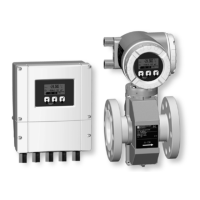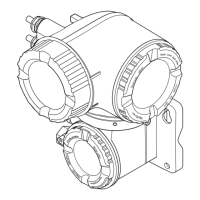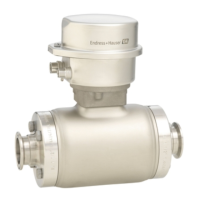Promag 53 PROFIBUS DP/PA Wiring
Endress+Hauser 47
Example
In accordance with manufacturer specifications, 9 repeaters can be switched in series when
using a standard line. The maximum distance between two bus users at a transmission rate
of 1.5 MBit/s can be calculated as follows: (9 + 1) x 200 m = 2000 m
Spurs
Note the following points:
• Length of spurs < 6.6 m (21.7 ft) (at max.1.5 MBit/s)
• No spurs should be used for transmission rates >1.5 MBit/s. The line between the
connector and the bus driver is described as a spur. Experience has shown that you should
proceed with caution when configuring spurs. For this reason, you cannot assume that the
sum of all spurs at 1.5 MBit/s will be 6.6 m (21.7 ft). This is affected greatly by the
arrangement of the field devices. Therefore, we recommend that if possible, you do not use
any spurs at transmission rates >1.5 MBit/s.
• If you cannot avoid using spurs, then they may not include any bus terminators.
Bus termination
It is important to terminate the RS485 line correctly at the start and end of the bus segment,
since impedance mismatch results in reflections on the line which can cause faulty data
transmission.→ 79
Further information
General information and further notes regarding the wiring are contained in BA034S/04:
"Guidelines for planning and commissioning, PROFIBUS DP/PA, field communication."
4.1.2 PROFIBUS PA cable specification
Cable type
Twin-core cables are recommended for connecting the device to the fieldbus. Following IEC
61158-2 (MBP), four different cable types (A, B, C, D) can be used with the fieldbus, only
two of which (cable types A and B) are shielded.
• Cable types A or B are particularly preferable for new installations. Only these types have
cable shielding that guarantees adequate protection from electromagnetic interference
and thus the most reliable data transfer. In the case of type B multi-pair cables, multiple
fieldbuses with the same degree of protection may be operated on one cable. No other
circuits are permissible in the same cable.
• Practical experience has shown that cable types C and D should not be used due to the lack
of shielding, since the freedom from interference generally does not meet the
requirements described in the standard.
The electrical data of the fieldbus cable have not been specified but determine important
characteristics of the design of the fieldbus, such as distances bridged, number of users,
electromagnetic compatibility etc.
Type A Type B
Cable structure Twisted pair,
shielded
One or more twisted pairs, fully shielded
Wire cross-section 0.8 mm
(AWG 18) 0.32 mm
(AWG 22)
Loop-resistance (DC) 44 /km 112 /km
Characteristic impedance at 31.25 kHz 100 ± 20% 100 ± 30%
Attenuation constant at 39 kHz 3 dB/km 5 dB/km
Capacitive asymmetry 2 nF/km 2 nF/km

